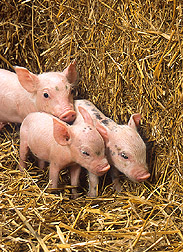|
Read the
magazine
story to find out more. |
|

Young pigs fed diets supplemented with inulin
absorbed more iron from their feed than pigs fed the same diet without inulin.
Piglets were used because their gastrointestinal tract and digestive physiology
are very similar to those in humans. Click the image for more information
about it.
|
|

|
Common Plant Compound Improves Iron
Absorption
By Ann
Perry January 2, 2008
Swine research funded in part by the Agricultural Research Service (ARS) indicates that inulin—a complex
carbohydrate found in many plants worldwide—may help people absorb more
iron from fruits, vegetables and grains. This finding by ARS plant physiologist
Ross
Welch and his colleagues could provide key support in the worldwide fight
against iron deficiency.
Welch, who works at the
U.S.
Plant, Soil and Nutrition Laboratory in Ithaca, N.Y., was part of a study
team that included Cornell University
scientists Koji Yasuda, Karl Roneker, Xingen Lei and Dennis Miller. Young pigs
were used for the study because their gastrointestinal tract anatomy and
digestive physiology are very similar to human anatomical structures and
physiological processes.
The pigs were divided into three groups. One group was fed a corn- and
soy-based diet low in iron, and the other two groups were given similar diets
supplemented with either 2 or 4 percent purified inulin.
Pigs that ate grains supplemented with 4 percent inulin showed a 28
percent improvement in absorbable iron and a 15 percent improvement in blood
hemoglobin concentration over those consuming inulin-free feed. They also had
higher soluble iron concentrations in the proximal, mid and distal colon.
Without inulin, the colon absorbs very little iron from plant-based
foods such as soybeans and corn because these grains contain high amounts of
phytic acid that inhibit iron absorption. But the beneficial bacteria that
ferment inulin in the colon release short-chain fatty acids. These increase
digestive acidity, which makes iron more soluble, and also causes mucosal cells
to proliferate. This produces more cell surfaces on which iron absorption can
occur.
Within these gut mucosal cells, metabolic products from inulin
fermentation also activate a gene—Divalent Metal Transporter 1, or
DMT1—that's responsible for a protein required for iron uptake by
these cells.
These studies were co-funded by ARS and the
HarvestPlus program, which is
administered by the Colombia-based International Center for Tropical
Agriculture and the International Food
Policy Research Institute in Washington, D.C.
Read more
about this research in the January 2008 issue of Agricultural Research
magazine.
ARS is the U.S. Department of
Agriculture's chief scientific research agency.